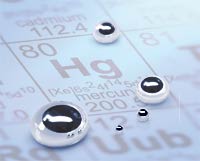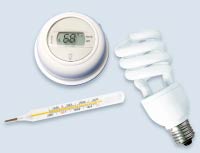About Mercury

What is Mercury?
Mercury, also known as quicksilver, is a naturally occuring element which has several forms. Metallic mercury is a shiny, silvery and odorless liquid that emits a colorless, odorless gas if heated. It occurs naturally, usually in the form of cinnabar, and is found in very small, yet concentrated amounts, in the earth's crust. Mercury combines with other elements, such as chlorine, sulfur or oxygen to from inorganic mercury compounds, or "salts". It can also combine with carbon to make the more toxic organic mercury compounds. The most common one, methyl mercury, is naturally produced by microscopic organisms in soil and water.

Mercury Products and Uses
Mercury metal has many uses. Because of its high density, it is used in barometers and manometers. With its high rate of thermal expansion that is fairly constant over a wide temperature range, mercury is found extensively in thermometers and thermostats. Mercury is important as an electrical contact for switches. Mercury conducts the charge in fluorescent lamps. Mercury-vapor lamps, which emit light rich in ultraviolet radiation, are used for street lighting, in water treatment plants as a disinfectant, and in tanning beds. Mercury is used as an electrode in the production of chlorine and sodium hydroxide and in certain electric batteries.
Since elemental mercury has been used since ancient times, it has developed many current and historical uses. It is used in the manufacture of certain chemicals, paints, batteries, electronic items, preservatives, anti fungal agents, and fluorescent lamps, high intensity discharge lighting and certain televisions. It is the major constituent of traditional dental amalgams. With its high rate of thermal expansion that is fairly constant over a wide temperature range, mercury is used extensively in thermometers, barometers and thermostats. It is also used in the production of chlorine and caustic soda.
In addition to its use in elemental form, mercury compounds also have many uses. Calomel (mercurous chloride, Hg2Cl2) is a standard in electrochemical measurements and in medicine as a purgative. Mercuric chloride (corrosive sublimate, HgCl2) is an insecticide, a rat poison, and a disinfectant. Mercuric oxide is used in skin ointments. Mercuric sulfate is a catalyst in organic chemistry. Vermilion, a red pigment, is mercuric sulfide; another crystalline form of the sulfide (also used as a pigment) is black. Mercury fulminate, Hg(CNO)2, is a detonator. Mercury forms many organic compounds. Mercurochrome (in 2% aqueous solution) is used in medicine as a topical antiseptic.
Most mercury pesticides have been withdrawn from the U.S. market, and many countries banned ocean dumping of mercury and other pollutants in 1972. Production of mercury-containing interior and exterior paints in the United States was phased out in 1991. Mercury, which has been used in medicines for hundreds of years, continues to be used in various folk remedies that deliver exposures. The use of mercury in dental amalgam for tooth fillings has stirred escalating controversy in recent years. Most other medical uses have been banned or are being phased out, and state and federal agencies are encouraging industry to reduce the amount of mercury being used and exported.